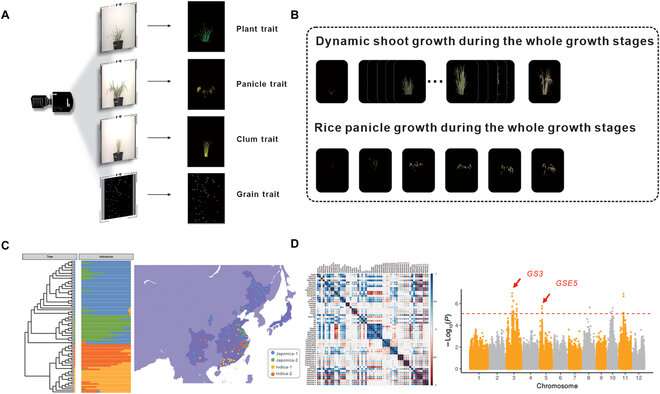This article has been reviewed according to Science X's editorial process and policies. Editors have highlighted the following attributes while ensuring the content's credibility:
fact-checked
trusted source
proofread
Researchers develop new strategy for acquisition and analysis of image-based phenome in rice

Researchers from the Institute of Genetics and Developmental Biology of the Chinese Academy of Sciences and Prof. Yang Wanneng's group from the Huazhong Agricultural University developed a strategy to acquire and analyze 58 image-based traits (i-traits) throughout the whole growth period of rice.
The study was published in Plant Phenomics.
In this study, based on the i-trait phenomes obtained, up to 84.8% of the phenotypic variance in the rice yield could be explained by eight traits among all the i-traits considered, and thus these traits could be used to predict the final rice yield better than predictions performed with other trait groups.
The results indicate that the i-traits obtained here can comprehensively reflect the growth status of rice, with the exception of the final yield.
To further explore the good environmental adaptability of the crop growth and development model, which would also show high inosculation with the latitude of the breeding region, the breeding region was divided into different latitude levels.
Interestingly, in addition to the HS of japonica rice showing an increasing negative correlation with the region latitude, some traits showed correlations with the regional latitude with significant differences among rice accession groups, such as PanicleTPA and TFN of indica rice, which may explain the difference in yield of different rice cultivars with the difference in the geographical environment of the breeding region.
Moreover, the differences in rice subspecies were analyzed using the image-based phenotypic traits, which, in addition to PlantYpar, indicated the senescence degree at the whole-plant and leaf level, and the HS, AveLW, and PanicleYPA terms also showed significant differences.
In addition, PCA was also performed for the characteristics of the rice accessions in the organ-temporal dimension, and GWAS using PC scores was used to identify genetic factors. Among the PC values of the organ and temporal traits, a QTL on chromosome 3, with a lead SNP on chromosome 3: 24262598, was detected by both the organ and temporal PCs, indicating that this locus deserves further study in the future with confirmations using larger panels.
As a proof of concept, this study demonstrates the potential value of this pathway in high-throughput phenomics studies and provides a reference for further similar studies in the future.
More information: Zhixin Tang et al, A Strategy for the Acquisition and Analysis of Image-Based Phenome in Rice during the Whole Growth Period, Plant Phenomics (2023). DOI: 10.34133/plantphenomics.0058
Provided by Chinese Academy of Sciences





















